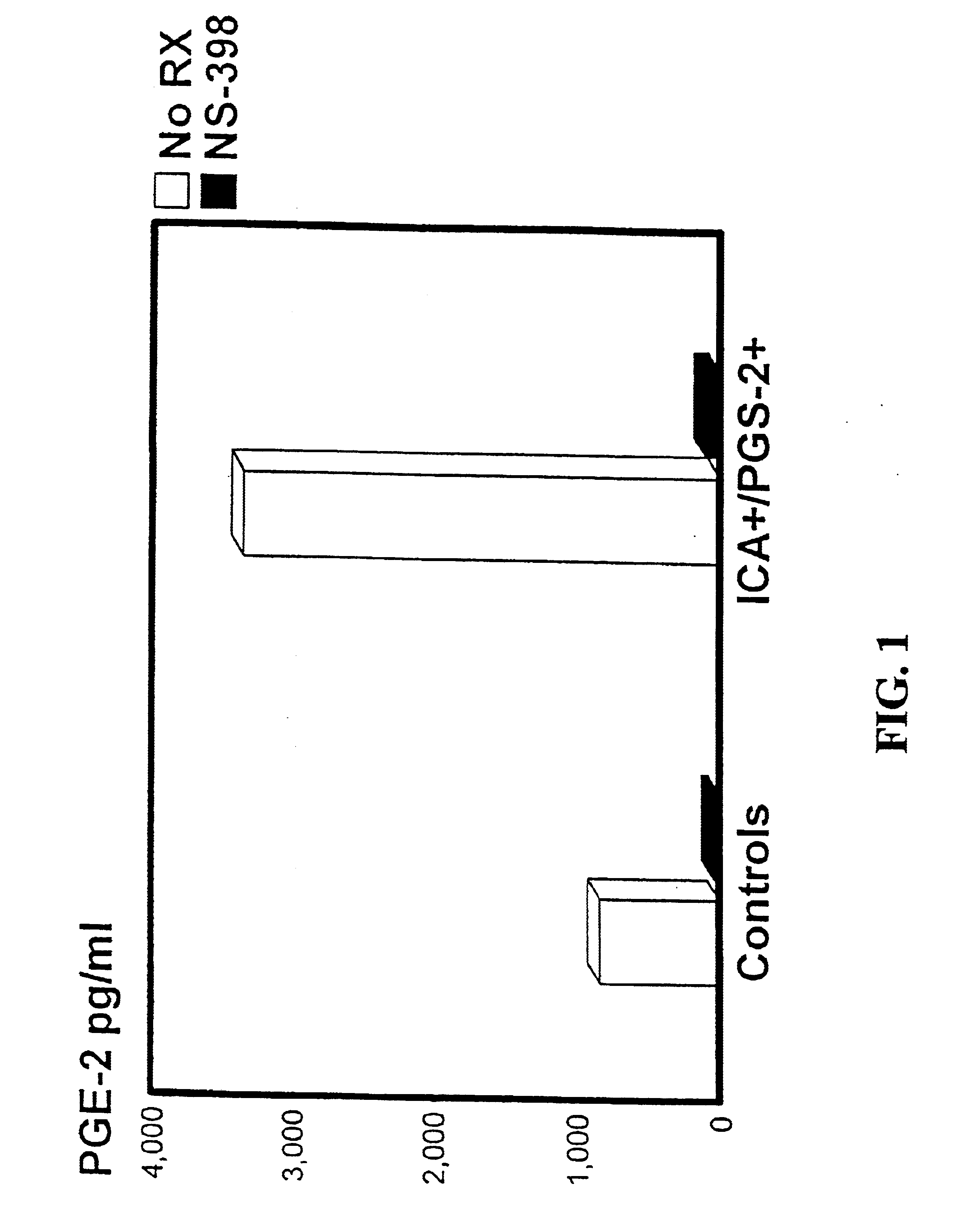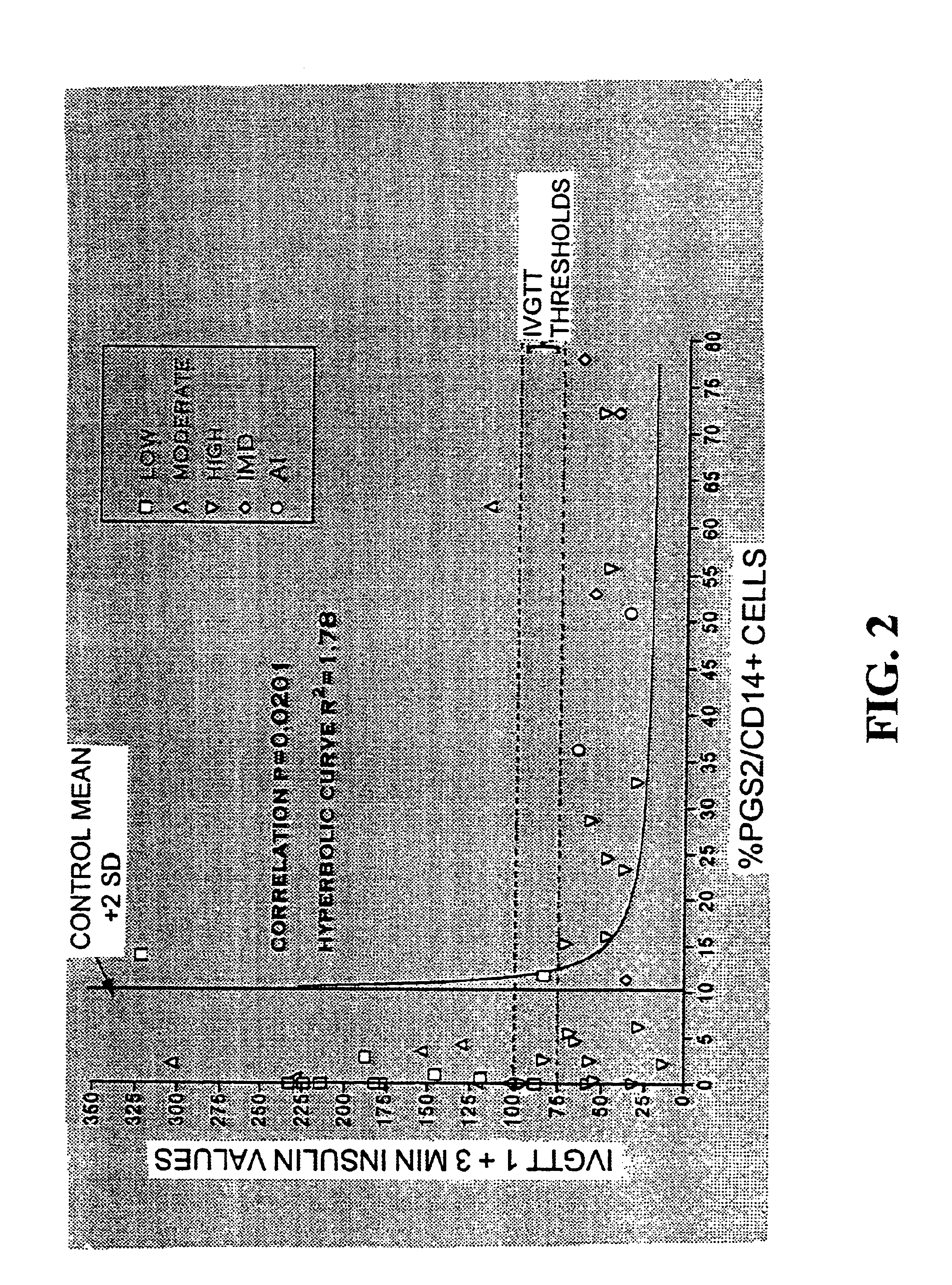Materials and methods for detection and treatment of immune system dysfunctions
a technology of immune system and materials, applied in the field of materials and methods for detection and treatment of immune system dysfunction, can solve the problems of not being able to completely prevent diabetes, a major public health problem, etc., and achieve the effects of/or other inappropriate cellular proliferation, preventing or reducing tumors
- Summary
- Abstract
- Description
- Claims
- Application Information
AI Technical Summary
Benefits of technology
Problems solved by technology
Method used
Image
Examples
example 1
Detection of PGS-2 mRNA
[0045]The regulation of mRNA and protein expression of PGS-2, the inducible enzyme critical for the production of large quantities of prostaglandins, was examined in macrophages of the NOD mouse. Macrophages from control mouse strains did not express PGS-2 mRNA as determined by the highly sensitive reverse transcriptase polymerase chain reaction. The PGS-2 protein is likewise not expressed in resting control macrophages as assessed by indirect immunofluorescence using a PGS-2 specific antibody. In marked contrast, NOD macrophages spontaneously express high levels of mRNA and protein for this enzyme as determined by these techniques. PGS-2 was also found to be expressed in the macrophages of NODscid / scid mice which lack functional T and B cells and, as a result, do not develop autoimmune disease or diabetes. The expression of PGS-2 in macrophages of NODscid / scid mice indicates that spontaneous PGS-2 expression is not dependent on the autoimmune milieu, and sugg...
example 2
Role of PGS-2 Expression in IDD
[0046]In order to more fully establish the genetic contribution of PGS-2 expression to autoimmunity in the NOD mouse, congenic mice were examined. The gene encoding PGS-2 is located on chromosome 1, 76.2 CM from the centromere. These mice, designated B6.NOD.C1, have a segment of chromosome 1 from the NOD mouse that contains the “NOD PGS-2 gene,” while the rest of the mouse genome is from the non-autoimmune C57BL / 6 mouse. Macrophages from B6.BOD.C1 congenic mice, like the NOD, spontaneously express PGS-2 mRNA and protein. These mice develop autoimmune disease in the pancreas, but unlike the NOD, do not develop diabetes. The absence of diabetes in these congenic mice is likely due to a lack of other key genes from the NOD that contribute other important factors to the overall disease process. Another line of congenic mice were designated NOD.B10.C1. These mice contain the NOD genome except for a segment of chromosome 1 derived from the non-autoimmune C57...
example 3
Blocking Activity of PGS-2 as Therapy for IDD
[0047]Blocking the activity of PGS-2 with drugs that reduce PG production can be used to prevent or slow the development of IDD disease. When NOD mice with established, active autoimmune disease are treated through their drinking water with a combination of drugs, including a PGS-1 / PGS-2 inhibitor, low dose indomethacin (3 μg / ml), in conjunction with an inducible nitric oxide synthase (iNOS) inhibitor, aminoguanidine, which potentiates the effects of indomethacin, the incidence of diabetes in NOD mice drops by 42% in comparison to control animals and animals treated with either low dose indomethacin or aminoguanidine alone.
[0048]Treatment of NOD mice at a time when autoimmunity is in its final stages with high doses (15 μg / ml) of indomethacin alone reduces the incidence of diabetes from 77% to 22%. These data demonstrate a strong effect of PGS inhibitors on the development of IDD.
PUM
| Property | Measurement | Unit |
|---|---|---|
| molecular weight | aaaaa | aaaaa |
| weight loss | aaaaa | aaaaa |
| inherent resistance | aaaaa | aaaaa |
Abstract
Description
Claims
Application Information
 Login to View More
Login to View More - R&D
- Intellectual Property
- Life Sciences
- Materials
- Tech Scout
- Unparalleled Data Quality
- Higher Quality Content
- 60% Fewer Hallucinations
Browse by: Latest US Patents, China's latest patents, Technical Efficacy Thesaurus, Application Domain, Technology Topic, Popular Technical Reports.
© 2025 PatSnap. All rights reserved.Legal|Privacy policy|Modern Slavery Act Transparency Statement|Sitemap|About US| Contact US: help@patsnap.com



